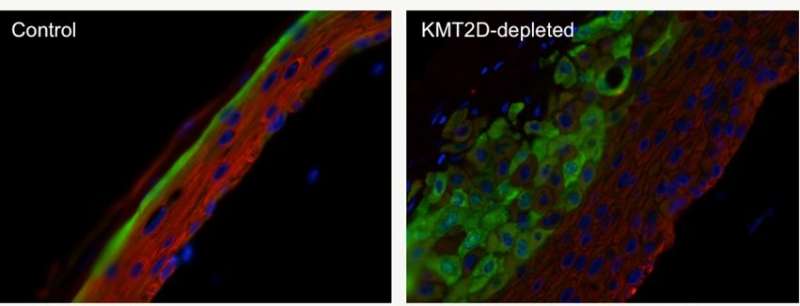Highly mutated protein in skin cancer plays central role in skin cell renewal

Approximately once a month, our skin completely renews itself. If this highly coordinated process goes awry, it can lead to a variety of skin diseases, ranging from skin cancer to psoriasis. Cells lining such organs as skin and the gut, lungs, and many other organs (collectively called epithelial tissue) rely on a delicate balance of self-renewal, proliferation, and differentiation. However, disruption of this equilibrium may drive cancer and other disorders.
Researchers from the Perelman School of Medicine at the University Pennsylvania have shown for the first time that a key protein called KMT2D involved in the epigenetic regulation of gene expression guides this renewal. They published their work this month in Genes & Development. Epigenetics involves chemical modifications to DNA and its supporting proteins that affect the availability of genes to be "read" and made into proteins.
"We have known that KMT2D is one of the most frequently mutated genes in all of skin cancer, as well as other epithelial cancers such as those of the lung, esophagus, mouth, and throat," said senior author Brian C. Capell, MD, Ph.D., an assistant professor of Dermatology and Genetics. "However, prior to this study, we had no idea how those mutations caused cancer or even what KMT2D did in these tissues. Now, armed with this knowledge, I envision in the near future we may be able to test the ability of novel epigenetic drugs to reverse these deleterious mutations."
In the study, when the researchers depleted KMT2D from human skin cells, undifferentiated stem cells could not multiply normally, causing premature differentiation of the tissue into a more mature, differentiated state. As a result, when grown in three-dimensional cultures, the different layers of skin epidermis became thickened and disorganized.
"Our data suggests that KMT2D is critical for the proper coordination of our skin's turnover process," Capell said. "Because epigenetic changes are reversible, we hope that our ongoing studies in KMT2D mouse models will ultimately lead to identifying and testing new topical therapies preventing and treating skin cancer in people."
More information: Enrique Lin-Shiao et al. KMT2D regulates p63 target enhancers to coordinate epithelial homeostasis, Genes & Development (2018). DOI: 10.1101/gad.306241.117



















